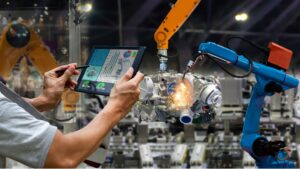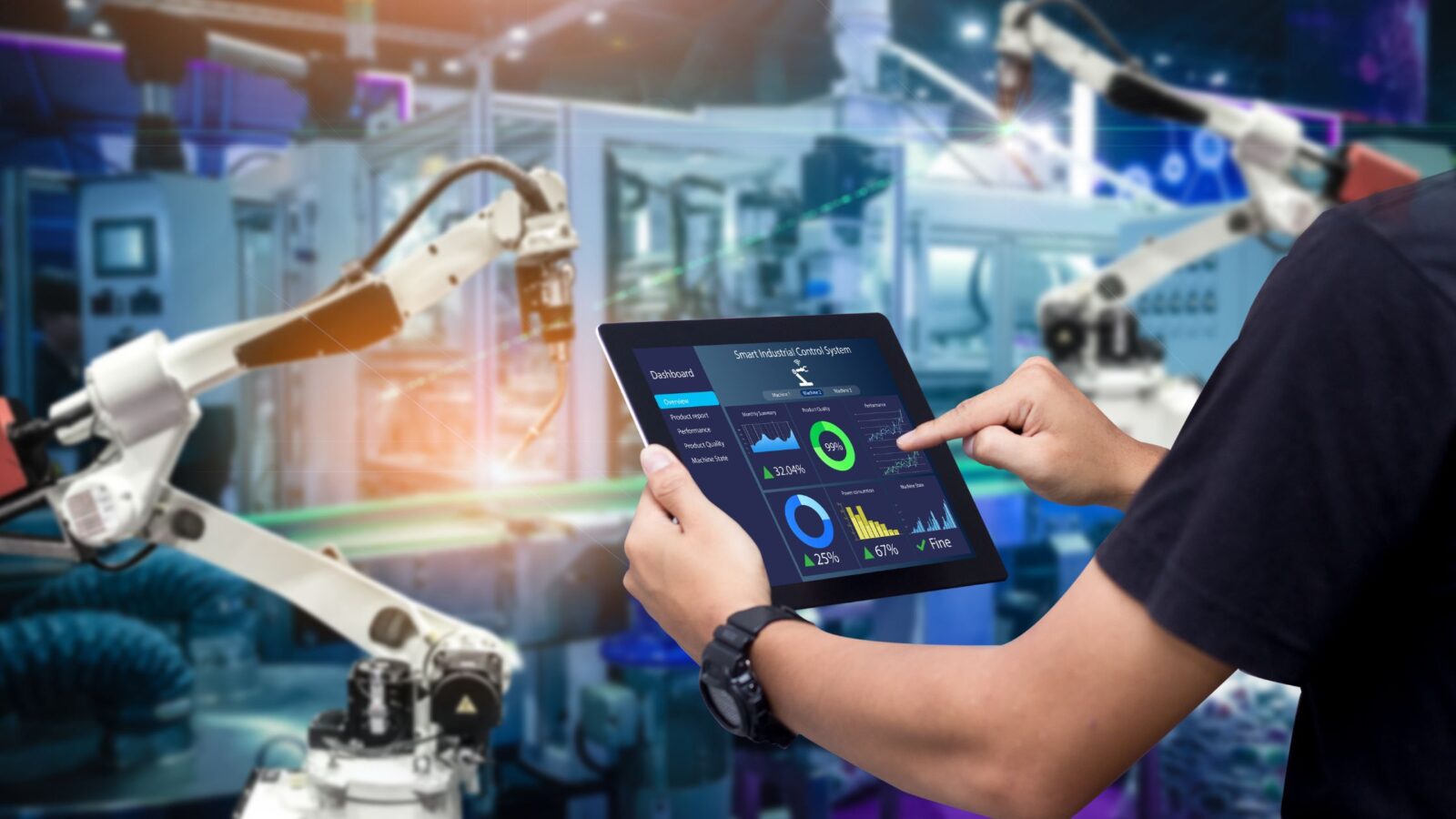AI in a Smart Factory
A quiet revolution is taking place in the world of modern industries. Smart factories, armed with the power of AI, are reshaping manufacturing as we know it.
Their story is one of soaring productivity, cost-cutting mastery, unyielding quality, unmatched efficiency, and the conquest of downtime.
Join us in uncovering this manufacturing marvel.

Benefits of AI in smart factory
As artificial intelligence (AI) transforms manufacturing, it brings with it a new era of smart factories that are more efficient, productive, and cost-effective.
From predictive maintenance to quality control to supply chain management, companies are using AI-powered solutions to optimize every facet of their manufacturing processes.
In this section, we will delve into five key advantages of implementing AI in smart factories:
#1. Increased productivity
AI’s impact on productivity is transformative. Machines integrated with AI can operate around the clock with unparalleled precision. They tirelessly perform tasks with consistency and speed, ultimately leading to a significant boost in production output. This not only increases the quality of products but also ensures that the output meets the stringent quality standards of modern manufacturing.
#2. Reduced costs
Cost-effectiveness is a paramount concern in the manufacturing industry. AI provides solutions to reduce operation expenses through predictive maintenance, optimized energy utilization, and streamlined processes.
By proactively addressing maintenance needs and optimizing resource allocation, AI minimizes unnecessary expenditures, allowing smart factories to run more efficiently and profitably.
#3. Improved quality
Quality standards in manufacturing are non-negotiable. AI-driven quality control systems carefully inspect products, detecting even the most micro defects. This strict inspection guarantees top-tier product quality. By eliminating defects and inconsistencies, smart factories using AI ensure that customers receive products that consistently meet the highest standards of excellence.
Such unwavering commitment to quality not only builds customer trust but also establishes the factory’s reputation as a paragon of excellence in the industry setting the stage for sustained success.
#4. Increased efficiency
Efficiency standards in manufacturing are paramount. AI is revolutionizing smart manufacturing by significantly enhancing efficiency. AI-driven solutions streamline production processes, optimize resource allocation, reduce waste and improve adaptability. This leads to significant reductions in lead times and cycle times ensuring materials, labor and machinery are employed with utmost efficiency, ultimately enhancing productivity, reducing cost and making manufacturers more competitive in the evolving industry.
#5. Reduced downtime
AI is a formidable tool in minimizing downtime, a critical aspect of smart manufacturing. By continuously analyzing data from sensors and machinery, AI predicts and prevents equipment failures before they occur. This proactive approach replaces costly unscheduled downtime with scheduled maintenance, ensuring uninterrupted, efficient factory operations.
Reduced downtime not only sustains productivity but also safeguards profitability. Smart factories with AI, deliver products on time, staying competitive globally.
Scenarios of AI in smart factory
With artificial intelligence (AI), manufacturing is undergoing a transformation, enabling new and innovative scenarios that increase productivity, efficiency, and quality. AI will revolutionize manufacturing processes, from predictive maintenance to quality control to supply chain management.

Our goal in this section is to explore five keyways in which AI transforms smart factories.
#1. Predictive maintenance
AI can analyze data from sensors on machines and equipment to predict when maintenance is needed. This allows the company to schedule preventive maintenance and avoid unplanned downtime. This can lead to significant cost savings and productivity improvement.
For example, monitoring a critical piece of equipment’s temperature using artificial intelligence-based predictive maintenance can be useful. The system could send an alert to the maintenance team if the temperature starts to rise, indicating that the equipment may need to be serviced soon.
#2. Quality control
AI-infused quality control systems outshine human inspectors by inspecting products with unparalleled precision, minimizing the prevalence of defective items.
For instance, an AI-driven quality control system could meticulously examine food products for contaminants. It employs cameras and sensors to capture product data, subsequently analyzed by AI. This enhances product quality and curtails the chances of recalls.
#3. Production planning and optimization
AI, when applied to production planning, expertly juggles variables like customer demand, inventory, and machine availability, all while enhancing efficiency and slashing costs.
Take, for example, an AI-powered production planning system that schedules car production, guided by the ebb and flow of demand, part availability, and assembly line capacity. The outcome is a cost-conscious, high-yield production schedule.
#4. Robotics and automation
AI takes the reins, empowering robots and automated systems to excel in tasks like welding, assembly, and packaging with unparalleled precision and efficiency, surpassing human capabilities. This reallocation of tasks enables human workers to tackle more intricate challenges, culminating in an overall boost in manufacturing efficiency.
For example, an AI-powered robotic welding system could be used to weld the parts of cars together. The system could use cameras and other sensors to position the parts accurately and to ensure that the welds are of high quality.
#5. Supply chain management
AI comes to the fore in optimizing supply chains by predicting demand, managing inventories, and fine-tuning transportation and logistics, leading to cost reductions and enhanced customer service.
For example, envision an AI-powered supply chain management system. It forecasts product demand, meticulously considering historical sales data, seasonal trends, and economic conditions. This precise forecast empowers the company to methodically plan production and inventory levels.
Conclusion
In conclusion, AI is transforming smart factories by increasing productivity, reducing costs, improving quality, enhancing efficiency and minimizing downtime. These scenarios are shaping the future of manufacturing, making smart factories more competitive and adaptable.








